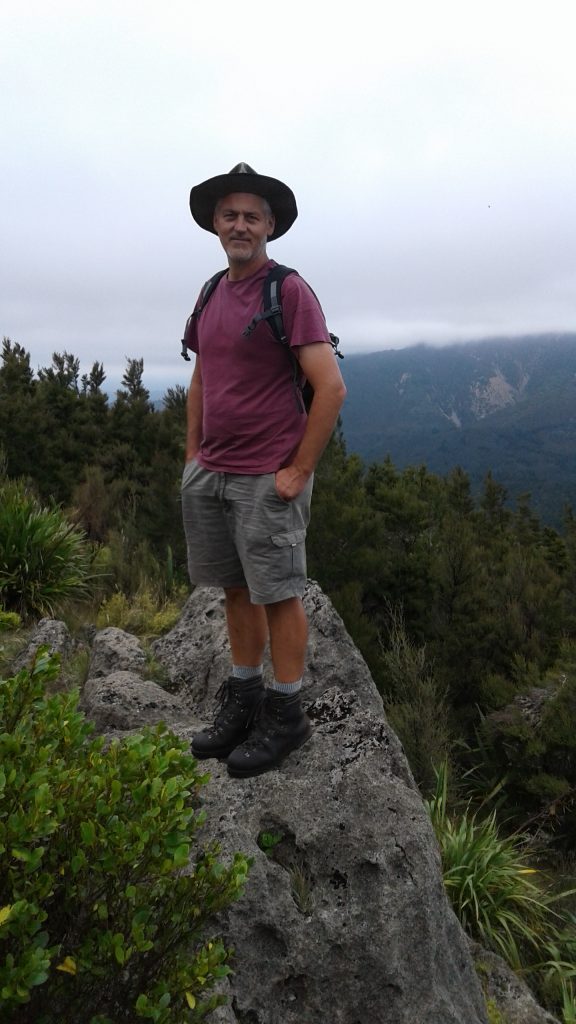6pm on Friday 4th December 2020 – Lecture Theatre 1, EIT Taradale
Cost: $10 a head for drinks and nibbles; pay cash at the door
Limited to 60 people max. – members having priority booking
To book, email: * secretary@hawkesbay.rsnzbranch.org.nz *
Research Awards 2020 in Wellington: Professor David Tipene-Leach (Eastern Institute of Technology) won the Tahunui-a-Rangi Award at an event hosted by the Governor General and the Royal Society of New Zealand! Here is David pictured with HB Branch President Dr Emre Erturk (left). Congratulations!

Monday 9 November 2020: Linear to Circular Bioeconomy: New Zealand’s opportunities and challenges in the 21st century
Link for Dr Graichen’s Slides
Monday 9 November 2020 – 6:00 PM

Lecture Theatre 1, EIT Taradale
How do you create a world without waste, where value stretches beyond monetary value? On the journey towards true sustainability, economy, environment and society must work together, not against each other. This is critical for a world that is facing challenges like feeding 10 billion people by 2050, a plastic waste flood and reduced availability of finite resources.
Scion’s 2030 Strategy is simply summed up in 9 words – Enabling New Zealand to transition to a Circular Bio-economy! This presentation will outline how Scion technologies and innovations can lead not only to a post COVID-19 economic re-build, but a fundamental shift. Specific focus will be on plastics and adding value to primary industry side and waste streams – both examples for the challenges and opportunities that arise through the transition to a circular bio-economy. Considering the ongoing discussions around sustainability and plastics, it is easy to forget that plastics have played an important role in several sectors, resulting in improved health, energy savings, increased crop production, improved food quality and reduction of food waste, as well as improvement of overall ecological footprint.
Dr Florian Graichen is Scion’s General Manager for Forests to Biobased Products. In this science and innovation area, activities are directed at solving new product and process challenges arising from the demand for products made from renewable resources. Customisation and circular design thinking are at the heart of all innovations. Examples include the development of advanced biobased performance products, holistic packaging solutions, reuse and recycling of primary sector side streams and waste (valorisation), and agile modular and mobile processing (additive manufacturing).
Scion is a Crown Research Institute that specialises in research, science and technology development for the forestry, wood product, wood-derived materials, and other biomaterial sectors.
Monday 2 November: Biodiversity in Hawke’s Bay – what’s our future?
Link for Professor Clarkson’s Slides
Monday 2 November 2020 – 6:00 PM

EIT Lecture Theatre 1, 501 Gloucester Street, Taradale
Biodiversity – the variety and diversity of living things that inhabit our world – is a hot topic. Recognising that much of New Zealand’s biodiversity is declining, two major strategies that seek to protect it are currently under development or being implemented. Both Te Mana o te Taiao/ Aotearoa NZ Biodiversity Strategy (launched in August) and the National Policy Statement for Indigenous Biodiversity (to be finalised by April 2021), demand action from councils and private landowners to work together to halt the decline and restore what has been lost. What does this mean for Hawke’s Bay, and how might our region respond to the inherent challenges and opportunities?
Bruce Clarkson is Professor of Restoration Ecology at the University of Waikato, where he leads a team of researchers within the MBIE-funded programme People, Cities and Nature: restoring indigenous biodiversity in urban environments. His research and on-the-ground action have assisted restoration of Hamilton’s gullies and the Waiwhakareke Natural Heritage Park. In 2006 he was awarded the Loder Cup, New Zealand’s premier conservation award and in 2016 he received the RSNZ Charles Fleming Award for environmental achievement. Professor Clarkson is chair of the Australasian chapter and a board member of the International Society for Ecological Restoration, and is ambassador for the New Zealand’s Biological Heritage National Science Challenge.
Wednesday 21 October 2020: From Drug Design to Future Fuels
Wednesday 21 October 2020 – 6:00 PM

Planetarium, Napier Boys’ High School, Chambers St, Napier
Nicholas Drinnan
What is the connection between: the biological activity of small molecules, lignocellulosic substances, the substrates and products of acidogenic fermentation, and a potential low emission diesel replacement fuel? At the core of an organic chemist’s understanding is the knowledge of carbon-based molecules, including their structure, function, synthesis, properties and uses. This presentation is a retrospective look at some of the projects and research areas I have been fortunate enough to be involved in over my career, and includes a consideration of the relevance of intellectual property rights in the context of research commercialization.
Nicholas Drinnan was born in Hawke’s Bay and returned to the Bay few years ago after having spent most of his career (so far) in Brisbane, Australia. His tertiary education crossed sciences, mathematics, philosophy and intellectual property law. He is a serial generalist with knowledge acquired, admittedly sometimes, more through obstinance (ahem, persistence) than aptitude. Current interests include building a recording console based on early 1970s discrete electronics and the oenological potential of wildling grape vines. An avid tramper and fisherman, when work allows, he may often be found in the Kawekas or on the Ngaruroro River.
Tuesday 6 October 2020: 2020 Geoscience NZ Hochstetter lecture – How tectonic and surface processes interact to shape the landscape
Tuesday 6 October 2020 – 6:00 PM

Hawke’s Bay Regional Council, Munroe and Vautier Street, Napier
Dr. Phaedra Upton
The landscape serves as a link between the solid Earth and the atmosphere. At many spatial and temporal scales, landscape morphology and topography provide a constraint on the tectonics of the Earth and processes active within it. To unravel these, we need to understand the complex relationships between surface processes, their drivers and the rocks upon which they act. Phaedra will explore recent developments in modelling tectonics and surface processes within a single deformational framework. She will focus on collisional settings such as New Zealand’s Southern Alps, SE Alaska and the Himalaya where rapid uplift combines with vigorous climate regimes to create dynamic landscapes.
Dr. Phaedra Upton: After a first class honours degree in Chemistry, Phaedra completed a PhD in Geology, and is now the Geodynamics Team Leader at GNS Science, where she has worked for the last 11 years. She has widely published on oblique collisional plate boundaries including the Southern Alps. More recently, tectonic geomorphology has become her main focus.
Thursday 1 October 2020: Common and German Wasps: Clever, Abundant and Raiding a Bee Hive Near You
Thursday 1 October 2020 at 7:00 pm

EIT Taradale, Lecture Theatre 1
Dr. Phil Lester
Wasps are feared and hated by many of us, with good reason – they sting. For anyone
who is allergic to their venom, a sting can mean a trip to hospital; for a very unlucky few, it can mean death. Wasps also place massive pressure on New Zealand’s biodiversity, especially on native birds, plants and insects, including our much-loved honey bees. They cause huge economic losses, estimated at more than $100 million each year. Native to Europe, Vespula vulgaris, the common wasp, has been inadvertently transported around the globe – usually travelling quietly, unseen, sleeping in people’s cargo. Today in New Zealand, the highest known wasp densities have up to 40 nests per hectare.
Phil Lester is a Professor in Ecology and Entomology at Victoria University in Wellington, New Zealand. He has published over 125 articles on invasive ants, wasps and other insects in journals that include Biology Letters, Ecology, and Proceedings of the Royal Society. Phil sits on the editorial boards of several journals, including Biological Invasions. He has won Fulbright and Royal Society Te Apārangi James Cook Research Fellowships.
The Astronomical Society: Equinox Lecture Series

Monday 21 September 2020: MacDiarmid Institute Regional Lecture Series 2020: Materials – Fact or Fiction?
Monday 21 September 2020 at 6:00 pm

EIT, Gloucester Street, Taradale, Lecture Theatre 1 (Broadcast on Screen)
Sting – the large Elvish dagger from The Hobbit and The Lord of the Rings – was wielded by both Bilbo and Frodo, and glowed blue whenever orcs were nearby. Nth Metal from DC Comics, is a hyper-conductive metal that has the ability to negate gravity, allowing a person to carry objects 20-70 times heavier than normal and to fly. From what we know of the periodic table and the world around us, could they exist in real life?
Join us for ‘Materials Fact or Fiction’, where MacDiarmid researchers delve into the periodic table to give us their scientific take on whether these could be reality in a not too far off future.
In order to accommodate any further changes in alert levels due to COVID, this year’s showcase will be in a digital format, with the option to either attend in person at EIT should that be possible and your preference, or to dial in from your own device. Please register here if you wish to dial in and we will send you the appropriate link to do so.
Dr Mike Price: MacDiarmid Institute Postdoctoral fellow in Physics, Victoria University of Wellington and
Dr Penny Brothers: Director of the Research School of Chemistry, Australian National
University and MacDiarmid Principal Investigator.
Joined by Otago Museum science communicator Dr Claire Concannon as MC. There’ll be two talks, a three minute animated video on the ‘science of lightsabers’, and time for Q&A.
Thursday 27 August 2020: Mathematics and Scottish Country Dancing
Thursday 27 August 2020 at 6:00pm

Planetarium, Napier Boys’ High School, Chambers St, Napier
Professor Rod Downey
There are those who would argue that these two activities are some of the pinnacles of human achievement. I work in mathematics and specifically algorithmics and the theory of computation. I am a teacher and deviser of Scottish country dances. I will try to explain how the cognitive processes in my kind of mathematics and dancing resemble one another. Whilst doing so, I hope to give insight into a small part of modern mathematics which I know something about and an interesting and fun dance form. I will illustrate with some videos and diagrams.
When interviewed by Radio New Zealand, I know that people found the combinations of mathematics, Scottish Dancing and surfing a strange mix, but at least the first two are completely natural.
The talk is meant for a general audience, and you won’t be forced to bring your dance shoes.
Professor Rod Downey came to New Zealand in 1986. He has worked at Victoria University of Wellington ever since. He works in several areas: mathematical logic, computability theory (the theory of computation), algebra, combinatorics and analysis. In the early 1990’s with Mike Fellows he co-invented Parameterized Complexity, which is a major branch of theoretical computer science; an area which uses “parameters” to understand running times or algorithms. As his Wikipedia page shows, he has won numerous awards, including two Shoenfield Prizes, and culminating in a Humboldt Prize and the 2018 RSNZ Rutherford Medal. He is currently developing a theoretical framework for Online Algorithms, which are the kinds of algorithms we deal with when we can’t see all the input. For example, each time you click on some website, in the background there is an online algorithm trying to target you to buy things.
